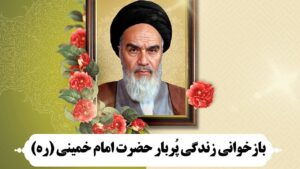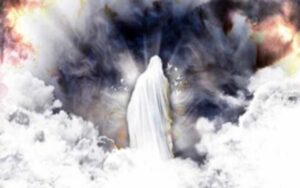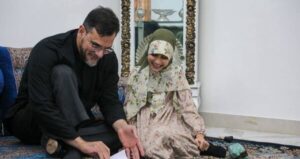Missionary thought and culture baseSheikh Lotfollah, a Shia jurist from Lebanon who migrated to Iran, first stayed in Mashhad and Qazvin and then in Isfahan. He was the father-in-law of Shah Abbas I. Shah Abbas built a mosque and a school to teach religion to the people in his name and chose the name Lotfollah for it. The mosque, which took 18 years to show its unique Isfahani style to the world, was designed by Shah Abbas himself.

The name of the building was changed several times throughout history, but its name remained Lotfullah. The unique features of special architecture, eye-catching and attractive tiles, tiles decorated with Quranic verses, hadiths and poems with the lasting calligraphy of Iranian calligraphers, have made world-renowned architects praise this building.
18 years to build Sheikh Lotfollah Mosque
The plan of Sheikh Lotfollah Mosque was used when the plan of Char Bagh and Bagh Hazarjerib was put into the stage of revenue implementation and during the era when Safavid architecture was flourishing. The construction of this mosque began in the first half of the eleventh century, in 1011 AH (1602 AD) and was completed in 1028 AH (1619 AD) by order of Shah Abbas I. The construction of this mosque lasted eighteen years.
Sheikh Lotfollah Mosque, a masterpiece by the hands of Mohammad Reza Esfahani
It is said that the architect of this mosque was Mohammad Reza Esfahani, son of Hossein Bana Esfahani. This mosque was built on the ruins of an earlier mosque. Sheikh Lotfullah Mosque is named after one of the great scholars of the Safavid era named Sheikh Lotfullah Jabal Aamili.
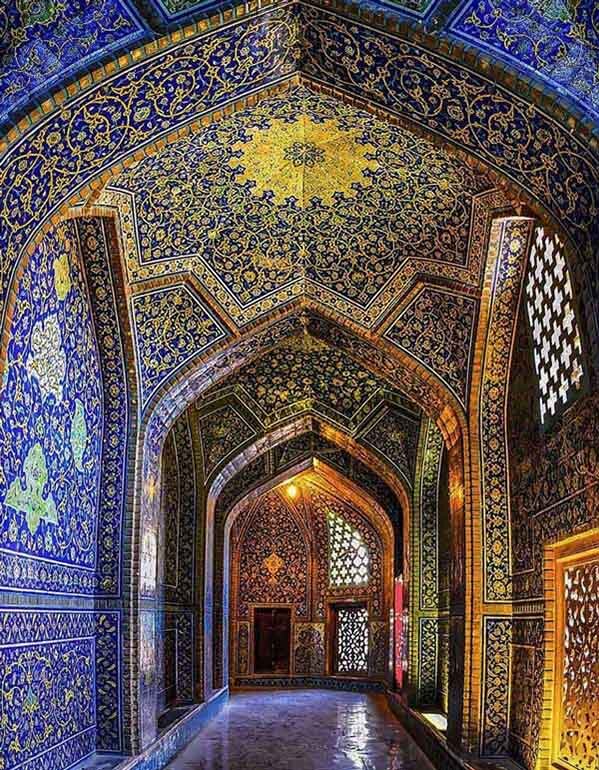
Sheikh Lotfollah was one of the great scholars of the Safavid era. He was one of the people of Jebel Amel Lebanon, a Shiite region in the south of Lebanon, who, like Sheikh Baha’i and some other scholars, migrated from Lebanon to Iran by Shah Abbas and first settled in Mashhad and Qazvin and then in Isfahan.
Holding Friday prayers in the absence of Imam Zaman
Since the Safavid government was a religious government and highly valued Islam and especially the Shiite religion, it also honored its scholars. On the other hand, Sheikh Lotfollah was the father of Shah Abbas’ wife. Therefore, a mosque and a school named after him were built in the Sheikh’s place of residence, where he was engaged in teaching jurisprudence and religious meetings.
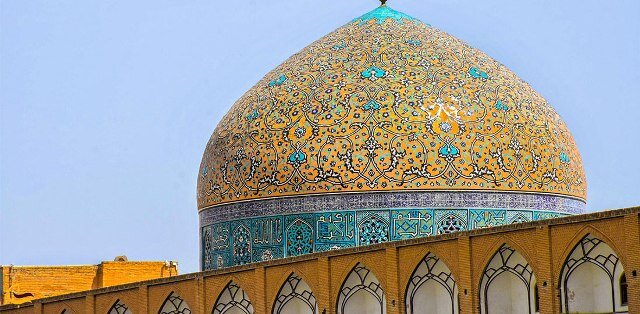
According to his request, the Sheikh considered it permissible to hold Friday prayers in the absence of the twelfth Imam of the Shiites, and he used to perform Friday prayers in this mosque, and his followers also followed him.
Shah Abbas gave the design of the mosque
The naming of this mosque is based on the name of the imam of its congregation, Sheikh Lotfollah bin Abdul Karim bin Ibrahim, who moved to Iran during the reign of Shah Abbas for religious reasons from Mays, one of the districts of Jebel Amal in Lebanon, and first settled in Mashhad, and there after requesting A number of scholars, including Mullah Abdullah Shushtri, entered the service of Astana Razavi on behalf of Shah Abbas the Great and lived in that city until the date of the Uzbekan sedition and his capture of Mashhad. He took refuge in Qazvin and started teaching there.
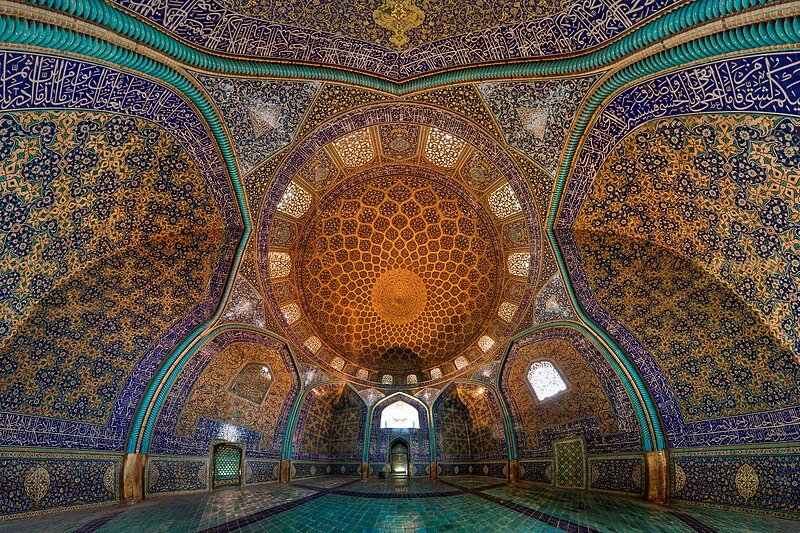
Shah Abbas brought him from Qazvin to Isfahan and in the year 1011 AH, he founded a mosque, which is still famous with his name, for his teaching place, residence and Imamate, and it took until 1028 AH to do this. It was during the completion of this building that Shah Abbas laid the grand design of the kingdom, Sheikh Lotfollah Mosque, in the southern part of Naqsh Jahan square. After Sheikh Lotfollah Mosque was prepared for him to pray.
Names that could not replace Lotfullah
During the Safavid period, this mosque was named after Mullah Fathullah, and after that it was called Sadr Mosque (Sadr or Sadr al-Ulama was called Mujtahid A’lam or Marja Taqlid), but today it is known by the same name as Olin.
The most beautiful tiles in Iranian architecture
The building of the mosque is based on a quadrilateral, which is turned into an octagonal structure in the upper part, and finally joins the stem of the dome in a circle.

The walls of the mosque have been built for the heaviness and pressure of the thick dome, and as it is measured from the windows, it reaches one meter and seventy centimeters and in the main parts it reaches more than two meters. The patterns and colors used in the elaborate tiling of the mosque dome. It is one of the most beautiful tiles in Iranian architecture.
Alireza Tabrizi Abbasi’s calligraphy on tiles
The tiling decorations of the Sheikh Lotfollah mosque are all covered with mosaic tiles from the ledges to the top.
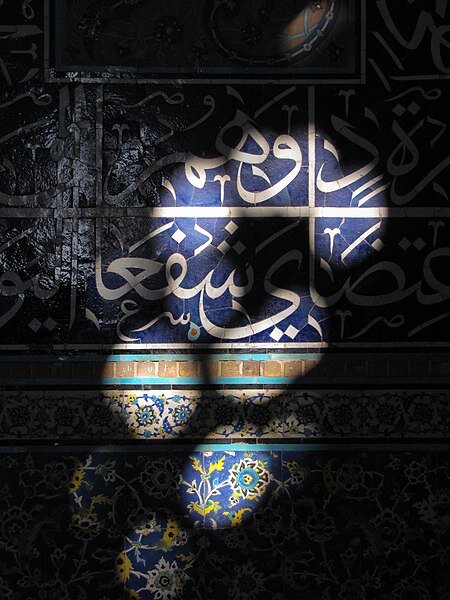
Some of the mosaic tiles inside and outside the dome and the inscriptions in the Tholut script are in Alireza Tabrizi Abbasi script.
A mosque that has no minaret and no courtyard
This mosque is not similar to other mosques due to the fact that it does not have a minaret, nor does it have an entrance hall (courtyard) and the entrance has stairs. The absence of a nave and an entrance court, this mosque is subject to the symmetry requirements of Naqsh Jahan square (the location of the mosque facing the Ali Qapo mansion), which has finally led to the issue of not being able to have a court or yard facing the Qibla that can be used for praying. It designed
Isfahani style mosque architecture
The architectural style of this building is Isfahani style. Jalo Khan Mosque begins by retreating from the eastern body of the square. After crossing four stairs, we reach the main area. The lower part of the walls of this area is covered with yellow marble, the big side platforms are also of the same type of stone.
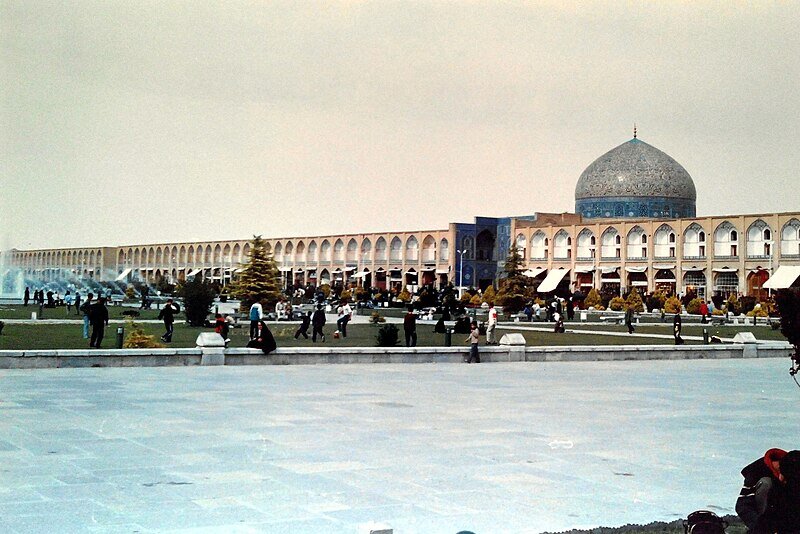
The entrance of the mosque is in the form of two lintels, which are made of plantain wood and are still standing after four hundred years. In front of the mosque, there is a beautiful octagonal pool, which was removed in 1316-1318 AH. At this time, the floor covering of the dome was made of plaster and the wooden windows installed in it provided the lighting of the basement. Sheikh Lotfollah mosque has no courtyard.
Praising the grandeur of mosque architecture from the language of foreign archaeologists
Its head was built and finished by the end of 1011 AH, and the completion of the building and its decorations was in 1028 AH. The head inscription in it is written by Alireza Abbasi and dated 1012 Hijri. The architect and builder of the mosque was Ustad Mohammad Reza Esfahani, whose name is mentioned inside the beautiful altar of the mosque in two small tablets as follows: The action of the poor and humble in need of God’s mercy, Mohammad Reza Bn. Professor Hossein Bana Isfahani 1028.
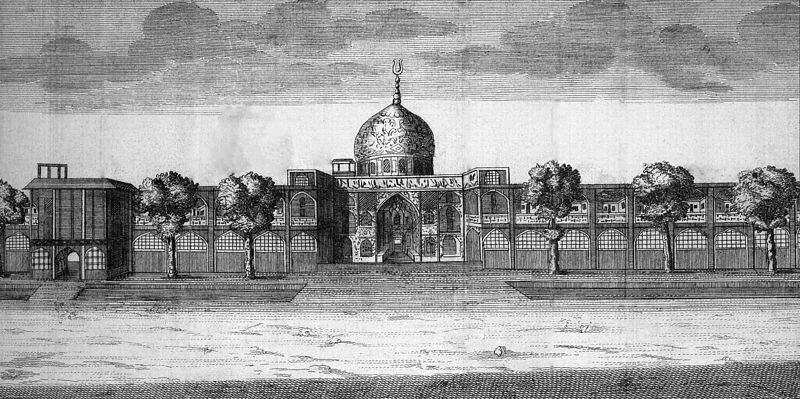
Painting from “Sheikh Lotfollah Mosque” by Jean Chardin
The lines and inscriptions inside the mosque are the work of Alireza Abbasi, a very famous calligrapher of the time of Shah Abbas and Baqir, the anonymous calligrapher of that period, whose example of Tholut calligraphy is equal to that of Alireza Abbasi. The inside and outside of the unique dome of this building, which is considered one of the most beautiful domes in the world, is covered with exquisite mosaic tiles. Foreign archaeologists have praised the grandeur of this mosque’s architecture. The use of natural light and beautiful colors are among the impressive features of this building.
A beautiful and hidden angle for the Qibla view
One of the characteristics of this mosque is its 45 degree rotation with the north-south axis, which is called “heel”. The reason for this rotation is that since the entrance of the mosque is towards the east of the square, if the mosque was built in the same direction, the work of orientation in terms of Qibla would be disturbed. Here, they have overcome this problem by creating a corridor that turns from the beginning of the mosque entrance to the left and then to the right; That is, although the building of the mosque is in the east, and from its external view, it appears that its front wall is in the north-south direction, but the wall is built in this mihrab, which faces the Qiblah. When we realize the greatness of this thought that there is no sign of crookedness or angle on the outside of the mosque, but as soon as we enter, we are forced to accept that the courtyard has a twist compared to the exterior, if the short dome of this mosque due to its circularity, direction or angle It does not show any opposition.
Hadiths and poems written in Baqir script according to eye-catching mihrab
One of the unique masterpieces of architecture can be seen in the altar of this mosque. In this mihrab, you can see exquisite tiling and very delicate muqrans, and there are also two tablets inside the mihrab with the words “The action of a poor, lowly person in need of God’s mercy, Mohammad Reza Ibn Ustad Hossein, built in Isfahan” is engraved on it. Other inscriptions written by Alireza Abbasi can be seen around the altar, on which a story of the Holy Prophet and the sixth Imam has been narrated. In addition to these narrations, poems are also written on the inscriptions, which according to the experts, the composer is “Sheikh Baha’i”, a scholar and poet of the Safavid era. The calligrapher of these inscriptions is Baqir Banna. The altar is very attractive because of its clean and smooth color, as well as its harmonious compositions and lines. The mihrab consists of a toothed arch, on which elegant Slimi motifs are engraved. This curved arch has shell-shaped muqarnas from the inside, which are decorated with beautiful plant motifs at the end.
Decorations that distinguish the mosque from other domes
The dome decorations of Sheikh Lotfollah Mosque are mosaic tiles, Islamic geometric motifs, repeated large stars with a pattern of tangled ivy, rhombus-shaped designs, flower and bush motifs, and calligraphy in Tholt script. Islamic decorations and Islamic art have been used to decorate different buildings in different periods and have a special place. One of the largest and most beautiful works of architecture and tiling of the dome of Sheikh Lotfollah Mosque has distinguished itself from other domes due to its grandeur, formal characteristics and the decorations on its surface.
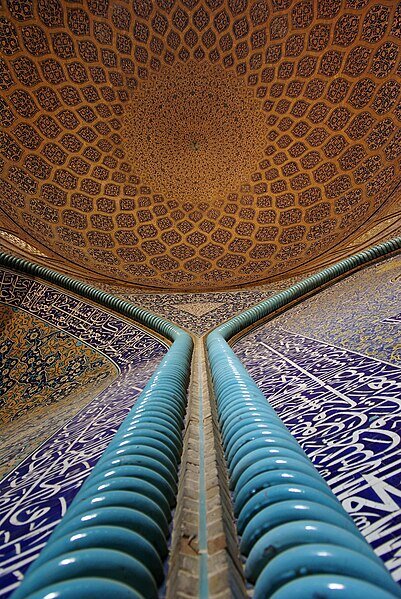
Over the past two years, the restoration of the Sheikh Lotf Mosque has had many side effects, from the claim of some so-called experts that there is no need to repair the dome, to the conversation of some media with unrelated experts such as artisans and archaeologists in connection with the matter of “repair” which It is a professional matter and that is about a mosque with greatness like the name of Sheikh Lotfollah. Unfortunately, during the renovations, major problems have arisen in the appearance and decorations, as well as the general form of the dome from different angles.
A ray of light in creating a spiritual atmosphere
The light inside the mosque is provided by mesh windows built on different sides of the dome stem. The light that shines into the mosque from these windows, in addition to providing sufficient lighting, is itself a display of the spiritual atmosphere of the building.
Sardar inscription decorated with Surah Juma and Nasr
The inscription at the head of the mosque and the two large circular inscriptions inside the dome, which draw attention to the lower part of the dome in the white thulth script on the background of the turquoise tile, are in the beautiful calligraphy of Alireza Abbasi, who was considered one of the most famous thulth writers during the reign of Shah Abbas I.
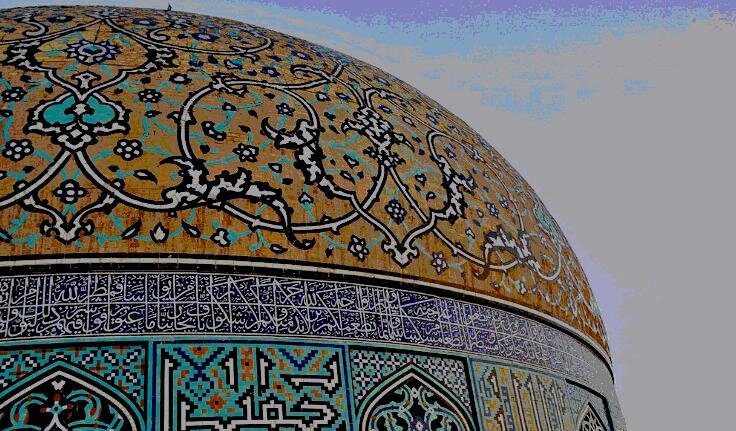
At the end of the first circular inscription, which describes the manners of entering the mosque according to the words of the Prophet of Islam, the name of Ali Reza is written as follows: “The Books of Ali Reza al-Abbasi in 1025” and at the end of the second circular inscription, which contains all the verses of Surah Juma and Surah Nasr is, the following phrase is written: “The books of Ali Reza al-Abbasi, God forgives sins”.
The finger to the mouth of the architects of the world
Louis Kahn, the world-renowned architect, during his visit to Isfahan, said this about Sheikh Lotfollah: I can only imagine such a work in the world of fantasy and with an ink of gold and silver.

Professor Pope wrote in the book “Review of Iranian Art”: “It is difficult to consider this work as a product of human hands; And he also stated in another place: There is not the slightest weakness in this building, the sizes are very suitable, the plan is very strong and beautiful, and in short, it is an agreement between a world of passion and excitement and a magnificent silence and peace that represents the rich taste of aesthetics. And it cannot have a source other than religious faith and heavenly inspiration. Also, due to the architectural and historical grandeur of this Iranian religious building, a joint stamp with the image of this building and a historical work has been published from China.
Peacock design in the dome
A peacock is designed in the inner center of the dome, whose feathers are complemented by the light entering from the arch above the entrance of the mosque.
Source: Processed in the editorial office of the Missionary
منبع: www.khabaronline.ir

